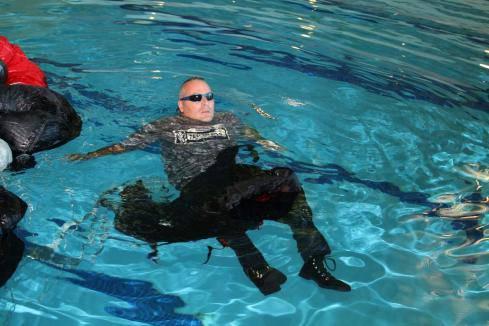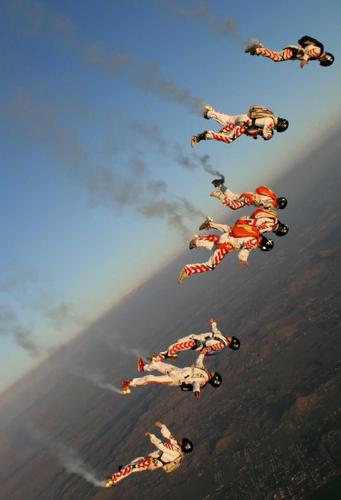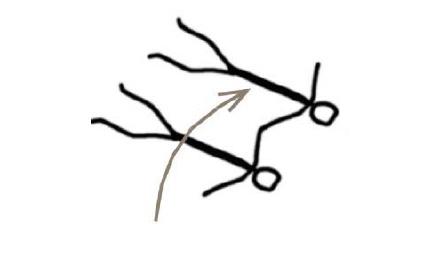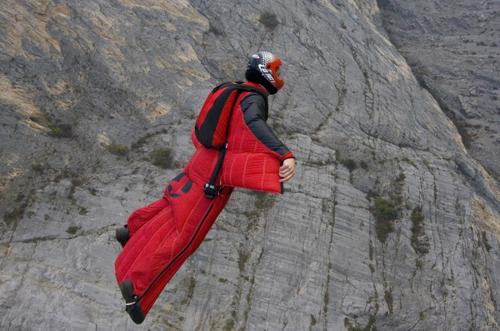Getting Wet: Wingsuits In The Water
An unplanned water landing is a frightening scenario for many skydivers; it’s
one of the reasons that live water training is required for a USPA B License (If
you didn’t truly get wet when working on your USPA B license, your instructors
weren’t doing you or anyone else any favors). Add a wingsuit to the mix and it’s
enough to give pause to even the most experienced skydiver. In 2010 alone, we’ve
had three known unintentional wingsuit water entries in the USA. Wingsuits can
fly further than skydivers can, and water is an attractive hazard to fly-over.
Toss in a low deployment, restricted movement, and some adrenaline and a normal
skydive can get really exciting really fast.
OK, so it’s not quite the same as Houdini and his locks, and skydiving in a
“prom dress” or freefall in a straight jacket isn’t nearly as difficult as some
make it out to be. However, emergency situations do require a different
approach. Wingsuit skydivers should pre-plan for an unintentional water landing
even if flight over water isn’t an issue at their home DZ. A boogie or other
special event may put wingsuit pilots into unfamiliar situations where water is
present. Flotation devices should be a part of that pre-planning process if
over-water flights are a common occurrence. TSA allows for up to four Co2 cartridges to be carried as part of a "life-vest unit."
USPA Training And Recommendarions
Section 6.2 of the USPA Skydiver Instruction Manual (SIM) guidance for
unintentional water landings tells us to:
a. Continue to steer to avoid
the water hazard.
b. Activate the flotation device, if available.
c. Disconnect the chest strap to facilitate getting out of the harness after
landing in the water.
d. Disconnect the reserve static line (if applicable)
to reduce complications in case the main needs to be cut away after splashing
down.
e. Steer into the wind.
f. Loosen the leg straps slightly to facilitate getting out of the harness after splashing down.
(1) If you
loosen the leg straps too much, you may not be able to reach the toggles.
(2) Do not unfasten the leg straps until your feet are in the water.
g.
Prepare for a PLF, in case the water is shallow (it will be nearly impossible to
determine the depth from above).
h. Flare to half brakes at ten feet above
the water (this may be difficult to judge, due to poor depth perception over the
water).
i. Enter the water with your lungs filled with air.
j. After entering the water, throw your arms back and slide forward out of the harness.
(1) Remain in the harness and attached to the canopy until actually in the
water.
(2) If cutting away (known deep water only), do so only after both
feet contact the water.
(3) If flotation gear is not used, separation from
the equipment is essential.
k. Dive deep and swim out from under the
collapsed canopy.
All of these same procedures apply when wearing a wingsuit, yet
preparations for an unintentional water landing don’t stop there. We still got
work to do.
Prior To Entering The Water
It goes without saying that the best way to avoid a water landing is to avoid
being over the water. However, sometimes it cannot be avoided. In addition to
the previously mentioned, USPA-recommended actions, the wingsuit should be
unzipped as much as possible prior to landing. This includes armwings, legwings,
and body zippers if possible. Do not pull the cutaway/release cables on the
wingsuit (assuming the wingsuit has cutaway cables, not all do) if the arms can
be unzipped. An armwing that has been cut away will be much more difficult to
move and unzip once it has filled with water and your arms are still in the
sleeves (For example, the newest Phoenix-fly wingsuit arms might be cut away, as
they detach the full wing from the arm, but the arm will still be inside a foam
sleeve making it difficult to swim). The tailwing may act as a drag point and
force the upper body forward, putting the skydiver on his belly. Enter the water
with feet and knees together. Flying at half brakes should allow the canopy to
continue forward. Do not flare. Take a deep breath prior to entering the water.
After Entering The Water
The canopy is a potential point of entanglement. It is recommended that a
main canopy be cut away once you are fully in the water. If there is a current,
this will prevent the main from dragging you along with it. A reserve cannot be
cut away without a hook knife (if you are going to carry a hook knife, carry a
metal, not plastic hook knife. A $5.00 hook knife will not do the job). Roll
backward or sideways onto your back. If you have not deployed the reserve, the
reserve will keep you floating for approximately 30 minutes in fresh water,
longer in saltwater. With the tail (and perhaps the armwings) potentially being
still inflated, being on your back will prevent the tail and rig from forcing
your face into the water. Try to remain calm, breathe deeply and begin the
process of removing goggles, helmet, and legstraps (chest strap if it was not
undone in the air). The arm and legwings of a three-wing style wingsuit are
similar to a ram-air parachute; there is an inlet and air fills the cells. These
same inlets and cells can fill with water as easily as they fill with air.
Although water in the cells alone will not cause the wingsuit to sink, movement
of the wing will cause the suit to be dragged downward. This means that
attempting to tread water will drag you under. Do not attempt to tread water,
but rather keep your legs motionless. If there is any current, it is imperative
that you stay on your back and try to keep your head upstream. Keeping the legs
apart will help achieve this goal. Even a slow current will move your body very
fast. Remaining calm is perhaps the most important aspect of clearing the suit
and surviving.
Jeans, boots, and gloves can make the task of escape a little more
difficult than expected.
Once you are fully unzipped and your legstraps loose, slide your rig and
armwings off. After the upper body has been freed, “sit down” in the rig and
suit to put you head-high. This allows the torso to roll forward so that it’s
possible to dive deep and away from the rig, allowing the legs to escape from
the legstraps and tailwing. Although the USPA SIM instructs skydivers to swim
away from their rig, I have made the personal choice that I
will not swim away from my rig if the reserve has not been deployed. It
may be used as a flotation device and might be the difference between life and
death. I will cut away the main canopy and swim away from the main.
This is my personal decision and is in opposition to
USPA recommendations. Follow at your own risk.
During the various water experiments, there were a total of 49 water entries
in various conditions and wingsuits, all with a rig or dummy rig in place, many
with a main canopy attached. Performance Designs Sabre II, Silhouette, and Storm
canopies were used. We jumped into still water 18’ deep, 6’ deep, current pools
34” and 24” deep with speeds up to 7 knots. We also jumped into wave pools with
swells of up to 3’, which are small to moderate compared to coastline
swells.
Tossing the main canopy into the 7 knot current
pool.
Summary
During these entries, three things became clear;
Go into the water with as many zippers undone as possible. Your chest strap
should also be undone for best possible speed once in the water. while this may
seem logical, in at least two of the three unintentional water landings, the
wingsuiter forgot to unzip arms while dealing with other issues.
Get onto your back as quickly as you can. Stay on your back as legstraps,
zippers, helmet releases, and goggles are removed. You may want to consider
leaving the helmet on if in moving water and head protection is needed.
Take a deep, calming breath. Even though my experiments were intentional
water landings, they were still nerve-wracking when the suits were fully zipped
up. Being jittery is entirely likely. Staying calm and keeping heart and
breathing rates down may easily be the difference in survival, particularly in
cold water.
Be sure to stay clear of the canopy and lines. Currents may drag the canopy
around a bit. Rescuers might have an easier time finding you if they can spot
the canopy in the water so staying somewhat near but well clear of canopy and
lines is a good idea. A hook knife should be part of your kit.
When landing in water that has a current, try to keep your head upstream
while getting out of the suit. Leave the helmet on to protect your head from
rocks and other objects. Stay as far away from the canopy as possible. This is
easier said than done. Note that in the video, the current combined with the
canopy drag was more than two men could manage even in shallow water. This is
where a hook knife would be beneficial.
If the rig has a reserve still packed in it, it will float. It also is very
easy to escape once the legstraps are undone, as it will remain on top of the
water as you dive forward away from the container.
"Exiting" from the 3 meter board, fully zipped
In conclusion, if over-water wingsuit flights are planned, seriously consider
a floatation device. They will not have a significant impact on the comfort of
the suit, and are not relatively expensive. ParaGear, ChutingStar, and other
skydiving supply shops sell these devices. Remember that CO2 cartridges may not
be carried aboard a commercial flight, so you’ll need to source or ship
cartridges to your final destination.
If a flotation device is not part of your gear/kit, have an advance plan in
the event of a water landing. There have been at least three known unintentional
water landings in the US this year; only through luck and calm procedures did
the wingsuiters survive. Read the Incident Report below to see how one survivor
described his experiences and how multiple errors led him into the water.
Big puffies and blue skies (and calm waters, I suppose)! -d
Douglas Spotted Eagle is a USPA AFFI, Coach Examiner, PRO, and PFC Senior
Examiner (North America) on staff at Skydive Elsinore.
Student’s Incident report:
#####
Name [Deleted]
My
age: 31
Years in the sport: 4.5 yrs.
# of skydives: 287
# of
Wingsuit SD’s: 7
# of BASE: 70+
I recently purchased a new Phantom2 Pheonix fly wingsuit and was super eager
to get in the air. I got to the DZ and got on the first available load which was
a 10 minute call. On any typical skydive, an immediete 10 minute call upon
arrival isn’t so bad, but setting up a wingsuit system quickly is not a great
idea, but I did.
Mistake #1: I forced myself to have to rush to get on a load to do a
technical jump for no apparent reason. In the end, I don’t think my rushed
preparation lead to the actual situation, but I guess my mind wasn’t where it
should have been.
I was the last to exit from 12,500?. I had a really great (mostly stable)
flight, flying around some clouds. At pull time, like most jumps, I was out over
the ocean. I took one last look at my wrist alti at 5K’. Based on my audibles
4000? warning, I’m guessing I was open between 3500?-3000?.
Mistake #2: I shouldn’t have pulled that low with a WS on with my low
experience level.
Mistake #3: I have made 6 previous WS jumps. All more than 2.5 years
ago. I did not physically or mentally dirt dive this jump before getting on the
plane.
After a stable pull (I felt), I immediatley opended with line twists. I’ve
had line twist before with this canopy/harness (Sabre 1, 150; 9 cell/Infinity
dom;1997) and was able to kick out of them in the past. This line twist began to
accelerate instantly. I made 3-4 attempts to kick out of it, but with the
restricted movement of my legs in the WS, and spinning horizontally around the
canopy, it didn’t do much at all.
Mistake #4: I was under too small of a canopy for a WS jump. My exit
weight= 240lbs. Wind loading= 1.6. I should have been under a more docile (7
cell), or larger canopy.
So, having no luck with my kick attemps, I chopped it. It took me a few
seconds to locate my handles (one hand on each). In my haste, I did a “T-Rex”
style cut-away. As soon as I saw my right riser clear, I let go of the handle
and pulled the reserve (also “T-rex”). Obviously leading to my main still
dragging off my left shoulder.
Mistake #5: I was jumping a borrowed rig. Although I’ve had about 20
uneventful (other than line twist) jumps with this rig. I wasn’t really familiar
with it.
Mistake #6: Probably the biggest one. I DID NOT CLEAR MY CUT AWAY
CABLE/HANDLE COMPLETELY!
Mistake #7: This goes right along with the above…Pulling my reserve
WAY TOO SOON!
I think because of my slightly slower descent rate (caused by my main still
being attached), and my reserve already fired, I felt the second set of risers
bouncing around on my head and saw all the lines whipping in-front of my face. As
the reserve was slowly coming to line stretch, the lines were beginning to
entangle with my helmet (actually the camera on my helmet)
Mistake #8: Wearing a camera on a “student” WS jump.
With the lines still “somewhat” relaxed, I thought of dumping my helmet but
instead I picked/brushed the lines off the camera, clearing them. A split second
later, I felt the canopy pressurize and go to complete line stretch. Instantly,
the reserve risers had forced my head completely forward, making my chin squeeze
into my neck. I knew I had MAJOR line twists on my reserve now too.
So now, I’m under one collapsed main still dragging off my left riser, and
one tightly twisted up reserve to my right side, still fully zipped into my WS,
and I’m getting choked from behind by the reserve risers and can’t lift my head
to see any of it. I knew I wasn’t “falling” anymore and that the canopies were
not entangled. I don’t know, but the reserve must have been “un-spinning” because
the pressure was slowly coming off the back of my neck and the twist opened up
enough to squeeze my head back through, behind the risers.
Mistake #9: Not sure if I could have prevented this one. If my arms
had been unzipped and out of the wings (which they weren’t) I may have been able
to reach back during the reserve deployment, and guided the risers in-front of
my head before pressurization.
At this point, my first objective was to finally cut the main off so I could
get completely out of my reserve line twists. The main was still being held on
by 1cm of ripcord cable still in the three ring release closing loop. In any
case…I was focused on getting that last tinny bit of rip cord out of the closing
loop. I had “tunnel” vision on trying to pick at the centimeter of cord. There
was too much tension on the riser so I couldn’t get it out. I was definitely not
thinking clearly at that moment. ALL I had to do was find my cut-away handle
floating behind me and pull it another 1/4 inch. In retrospect, the dragging
main (acting like an anchor) may have kept my reserve from continuing to twist
and spin me into the ground/water. I’m not sure if completely cutting away at
that point would have been any better.
Mistake #10: Had I been thinking clearly, I would have found my handle
and finished the job of cutting away.
At this point I stopped all attempts to correct anything. I saw that I was
about 300 yards(?) of the beach, over the water at about 500-300?(?) up. I knew
I was going for a swim. The swell was small (2-3?), but definitely was not flat
and calm. In preparation for my mid day swim, I started unzipping
everything…chest, arms, legs, chest strap. I then reached above the reserve line
twist, grabbed the rear/right line set and did a “rear riser” turn towards the
visibly shallower water over the reef. I don't know if that helped at all because
I pretty much felt like I was under a round canopy with no directional control.
I just knew I was drifting towards the reef now. Not knowing the shallowness
above the reef gave me a second of pucker factor, but at this point I had not
much control or time anyway. I then did a “backwards” PLF (obviously with no
flare, toggles still stowed and twisted). I slammed the water pretty hard.
Mistake #11: Although this is what saved me from serious impact, I
landed in the water with a WS on….not good!
While I was underwater, my wingsuit quickly turned into a tunasuit, but
before I even had time to deal with the next hurdle……..I stood up.
I was now standing 300 yards out in the surf, in 3 feet of water with both
canopies attached and the WS on, all filled with water. I was getting dragged
in-land with the swell a little bit, but had plenty of time to finally cut-away
the main and completely step out of the WS. I saw all the scrambling of people
on the shore. I was soon reached by a couple of skydivers and a rescue kayak. We
loaded up the rig on to the kayak and swam back to shore.
Mistake #12: I probably should have made my first priority to un-zip
my wings. Although, at no point did I feel like they were restraining my movement
(until I wanted to steer towards the reef). I guess I unzipped them right when I
had a moment and thought it was totally needed.
#######
Massive thanks to:
Lake Elsinore Casino
Tooele City Pool
Raging Waters/SLC
Skydive Elsinore
Skydive Utah
Performance
Designs
Rigging Innovations
Teledyne Instruments
Joey Allred, Aaron Hutmacher, Jose Calderon, Mannie Frances, Karl Dollmeyer,
Scotty Burns, Chuck Blue, Jarno Cordia, Bence Pascu, Joe Turner, Frank Hinshaw,
T.K. Hinshaw, Tom Deacon, Jim Crouch, Jack Guthrie, Scott Callantine, Jeanie
Curtis, Mike Harlon, Chris Squires, Robert Pecnik, Jeff Donohue, and Andreea
Olea.
By admin, in Disciplines,




